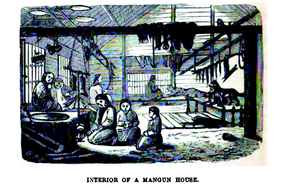Ultschen
The Ultschen ( Russian : ульчи , own names Ultscha , Nani ) are an indigenous people of the Russian Far East . In the 2002 census, 2913 residents stated that they belonged to the Ultschen nationality.
The original Ulschic language has died out today. The current language of the Ultschen belongs to the family of the Tungusic languages and was adopted centuries ago by the invading Tungus. It is believed that the Ultschen once spoke a language that was related to the language of the Niwchen or the Korean language .
Most of the Ultschen live in the Ultschski rajon , a rural district in the Khabarovsk region on the Amur River . Therefore fishing is the most important source of income and food.
The centuries of Russian influence on the Ultschen and other small peoples of Siberia has led to an extensive culturally Russification . On the other hand, the Soviet Union decided in 1989 to take far-reaching measures to stop or reverse this process: for example, teaching programs for hunting and fur farming were introduced. These laws were adopted by the Russian state in December 1991 after the collapse of the Soviet Union.
The Ultschen play a major role in researching the history of East Asia. Genetically speaking, they are a Northeast Asian people who are most closely related to today's Koreans . However, they also show a close relationship with other Siberian peoples and the Native Americans .
Web links
- The Nanaizen, Ultschen and Niwchen report of the radio station "Voice of Russia"
- Article Ultschen in the Great Soviet Encyclopedia (BSE) , 3rd edition 1969–1978 (Russian)
Individual evidence
- ↑ [URL https://www.gfbv.de/de/news/indigene-voelker-im-norden-russlands-und-sibiriens-174/ .] In: Information of the Society for Threatened Peoples South Tyrol, from Die kleine Völker des far north and far east of Russia. A current situation report with a historical and ethnographic introduction , Bozen 1998, accessed on September 15, 2019.
- ↑ Veronika Siska, Eppie Ruth Jones, Sungwon Jeon, Youngjune Bhak, Hak-Min Kim: Genome-wide data from two early Neolithic East Asian individuals dating to 7700 years ago . In: Science Advances . tape 3 , no. 2 , February 1, 2017, ISSN 2375-2548 , p. e1601877 , doi : 10.1126 / sciadv.1601877 ( sciencemag.org [accessed August 31, 2018]).
